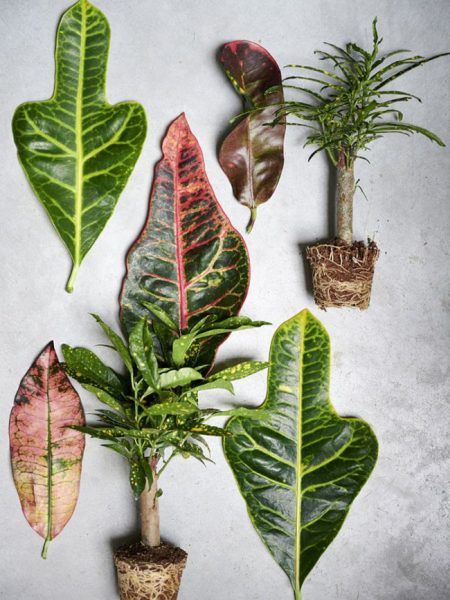02 Oct Croton: Houseplant of the Month for October 2020
Asiatic tough guy brings colour to your life
Green, yellow, red, orange, brown, purple, black – flamboyant Croton brings autumn’s glow into your home. It’s a very eye-catching plant with thick, shiny leaves that proclaim that Mother Nature had an exceptionally good day when she came up with this beauty. The best-known is the multicoloured Croton, but there are also varieties with just yellow and green markings. You have the choice of small or large leaves, and there is also one with narrow wavy leaves. It’s one of the few foliage plants that can tolerate direct sunlight. The official name is Codiaeum variegatum, but the name Croton is so well-established that we use that for consumers.

Croton range
There are many forms from large to small, including cultivars with various leaf shapes and leaf markings. They are all part of the species C. variegatum, which means variegated and refers to the multicoloured leaves. Some large-leaved cultivars are: Excellent, Petra, Norma, Mrs. Iceton, Nervia, Tamara and Wilma. Some small-leaved cultivars are: Gold Star, Gold Finger, Gold Sun, Mammi and Yellow Banana.

Origin
Croton grows in South-east Asia and the Indonesian archipelago. The plant is used as a hedge in many countries. In those regions Croton can grow very tall and spread outwards as a woody shrub. As a houseplant you usually encounter medium to XL specimens. The name is derived from the Greek word ‘kroton’, which means ‘tick’ and refers to the plant’s seeds, which look like ticks. Codiaeum is a member of the Euphorbiaceae family, which also includes other familiar houseplants such as Poinsettia and Crown of Thorns.
Care tips for customers
- Croton prefers a light to sunny spot. Allow the plant to acclimatise to a sunny spot first to prevent the leaves from being scorched.
- Never allow the soil to dry out completely, and be wary of water that is too cold in the winter, since this can cause leaf drop.
- Croton likes a shower and being sprayed. In the summer the plant can also be placed outside in the rain.
- Yellow or ugly leaves can be removed.
- If the plant has got too tall or less attractive, it can be pruned. It’s best to do this during the winter months when there is less light.
- Give houseplant food once a month.
- Preferably place in a cooler room (although it must still be at least 15°C) during the winter months to allow the plant to hibernate.
- During the summer months Croton can go out on the patio or balcony, provided that the temperature does not drop below 15°.
Sales and display tips
Croton fits with the urban interiors trend that rejects the perfectable world and embraces a hint of street culture with its bright colours. Display it in a nice recycled tin can, in a rubber pot made out of car tyres or in a container that is as colourful as the plant itself. It can be industrial and bold to make Croton a contemporary showstopper.
Images of Croton
You can download and use the images below free of charge if you credit Thejoyofplants.co.uk.
Instagram: @thejoyofplants
Facebook: @thejoyofplants
Twitter: @thejoyofplants
Croton posters
You can download the posters using the links below.


